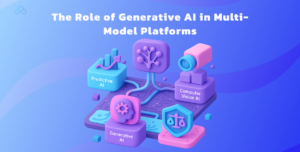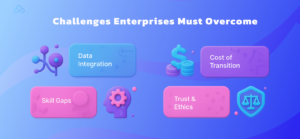Introduction
Artificial intelligence has already transformed the way businesses work, but we are only using the surface level of it. Companies across industries are moving from single AI models toward integrated multi-model platforms. This change is not just about scaling machine learning but also about preparing the right AI infrastructure to support the future of work. In this blog, let’s explore why multi-model platforms are transforming rapidly, how they fit into the Enterprise AI future, and why they are at the center of Generative AI adoption.
Understanding the Current AI Landscape
Over the past few years, enterprises have invested heavily in AI solutions. From automating repetitive processes to predicting customer behavior, AI has become a crucial go to tool for us. However, many companies depend on single-model approaches that solve one problem at a time. While these models have delivered results, they often create bugs and increase costs.
As the organizations grow, the need for a single ecosystem becomes important. And this is where multi-model platforms come in the picture. These platforms allow organisations to use various models like- natural language processing, computer vision, and generative AI services which are under one integrated AI infrastructure. Instead of operating multiple isolated enterprises can use diverse applications smoothly.
Why Multi-Model Platforms Are the Next Big Shift
1. Efficiency and Scalability
The Enterprise AI future is not about experimenting with tools. But it is more of scaling AI across business functions. A multi-model platform brings scalability by letting enterprises train, test, and implement multiple models at once. With a robust AI infrastructure, companies can save everything from fraud detection to personalized marketing under one roof.
2. Better Decision-Making
Previously the businesses had to work together with data to get insights from different models. And this slowed down the decision-making process. But now, multi-model platforms are combining insights from several AI models in current time. So, with this simple approach, executives get an overall view of operations which directly impacts strategic growth and helps accelerate Generative AI adoption.
3. Cost Optimization
Managing separate AI tools comes with extra expenses too. Multi-model platforms minimize duplication by centralizing resources. Companies can reuse the same AI infrastructure for multiple projects. And this not only saves money but also helps IT teams to optimize their AI infrastructure 2025 roadmap.
4. Faster Innovation
When enterprises use a multi-model setup the experimentation becomes easier. Teams can test new algorithms and integrate generative AI services without hindering existing workflows. This creates a culture of innovation and ensures businesses are future-ready.
The Role of Generative AI in Multi-Model Platforms

Generative AI has quickly moved from a trendy word to a business reality. It has applications across industries, from creating marketing content to developing prototypes. However, generative AI alone cannot meet every enterprise need. We need other AI models in a multi-model platform to make it more impactful.
Like, imagine a retail company using predictive AI to forecast sales such as computer vision AI to track inventory, and generative AI to personalize ads. All these models running on one AI infrastructure can create a magical ecosystem. And this kind of integration defines the Enterprise AI future and showcases the right value of Generative AI adoption.
Additionally, the growing availability of AI as a Service makes it easier for businesses to experiment with generative AI services without huge investments. Enterprises can switch these services into their existing systems and optimize decision-making at scale. Going ahead, as AI infrastructure 2025 evolves, we can expect generative AI to be deeply integrated in multi-model ecosystems to drive not just automation but intelligent collaboration between models.
Building the Right AI Infrastructure
For enterprises to embrace multi-model platforms, they need a solid foundation. This is where AI infrastructure plays a crucial role. Without reliable infrastructure the scaling of AI becomes impossible.
Key components of modern AI infrastructure include:
- Cloud-based environments: These allow companies to scale AI as demand grows.
- Data pipelines: Efficient pipelines ensure models get accurate and updated data.
- AI as a Service platforms: They provide ready-made tools for companies that want to accelerate Generative AI adoption without heavy upfront costs.
- Security frameworks: As data use increases, enterprises need robust protection to ensure compliance.
Going ahead, AI infrastructure 2025 will focus more on hybrid and multi-cloud environments. Companies will depend on simple systems that support both local and cloud-based AI models. This change gives enterprises the ability to handle large data while maintaining coordination.
How AI as a Service Supports Multi-Model Platforms
Providers now offer plug-and-play solutions that make it easier for companies to experiment with AI. As not every enterprise can build its own infrastructure from ground zero. And this is where AI as a Service becomes important.
For example, businesses can subscribe to generative AI services without setting up expensive servers. They can also use ready-to-use APIs for natural language processing or computer vision. This democratizes AI and accelerates the Enterprise AI future by making advanced technology accessible to all.
Use Cases of Multi-Model Platforms in Enterprises
Healthcare
Hospitals are using multi-model AI platforms to improve patient care. Predictive models forecast patient admission rates, generative AI helps in medical report summaries, and computer vision AI assists in analyzing scans. Together, they are working amazingly on one AI infrastructure.
Finance
Banks are early adopters of AI infrastructure 2025 strategies. Scams like fraud detection models, customer service chatbots, and credit risk models are all integrated into multi-model platforms. And this allows faster responses and stronger security.
Manufacturing
Factories use IoT data with AI models to forecast equipment failures. Integrating generative AI services helps them to simulate new designs. As running everything on one platform reduces idle time and speeds up innovation.
Retail
Retailers integrate recommendation engines, demand forecasting, and generative AI to customize customer journeys. This multi-model setup maximizes efficiency and drives better engagement.
The Enterprise AI Future: What to Expect
As we move closer to AI infrastructure 2025, enterprises will demand platforms that are:
- Interoperable – Able to integrate different AI models and tools.
- Scalable – Supporting business growth without disruptions.
- Cost-Effective – Reducing overheads while maximizing value.
- Secure – Protecting sensitive data while meeting compliance needs.
- Future-Proof – Ready for upcoming trends in Generative AI adoption.
The Enterprise AI future will no longer be about isolated projects. Instead, it will be about building ecosystems where multiple models work together to deliver results.
Challenges Enterprises Must Overcome

While the benefits of multi-model platforms are clear, adoption does not come without challenges. Some of the common hurdles include:
- Data integration: Combining data from different sources requires advanced pipelines.
- Skill gaps: Enterprises need trained professionals to manage complex AI systems.
- Cost of transition: Moving from legacy systems to multi-model platforms demands investment.
- Trust and ethics: As Generative AI adoption grows, companies must ensure responsible use.
Despite these challenges, the shift is inevitable. Companies that prepare today with the right AI infrastructure will be ahead in the race.
Practical Steps for Enterprises
If you are planning to adopt multi-model platforms, here are some steps to start with:
- Assess your current AI maturity – Identify existing models and gaps in your system.
- Invest in scalable AI infrastructure – Choose cloud or hybrid systems that support expansion.
- Experiment with AI as a Service – Use third-party tools to test capabilities before full-scale adoption.
- Prioritize data quality – Strong AI depends on clean, structured, and real-time data.
- Train your workforce – Upskill employees in managing AI platforms.
- Ensure compliance – Build ethical frameworks to handle sensitive information responsibly.
By following these steps, enterprises can move smoothly toward multi-model adoption and unlock the benefits of generative AI services.
Conclusion
The next phase of AI will not be about isolated solutions but about platforms that integrate multiple models under one strong AI infrastructure. Multi-model platforms represent the natural evolution of AI in enterprises. They bring efficiency, scalability, and innovation while reducing costs.
As we look at the Enterprise AI future, the combination of predictive, prescriptive, and generative models will become the new standard. Generative AI adoption will accelerate, and companies will rely more on AI as a Service to bridge the gaps. By preparing their AI infrastructure 2025 roadmap today, businesses can ensure they remain competitive tomorrow.
The shift is already underway, and enterprises that embrace multi-model platforms early will lead the transformation. The future of enterprise AI is here, and it is multi-model.
Frequently Asked Questions (FAQs)
- Why are multi-model platforms important for the Enterprise AI future?
Multi-model platforms allow enterprises to run different AI models on a single AI infrastructure. This improves efficiency, reduces costs, and accelerates innovation. - How does Generative AI adoption benefit businesses?
Generative AI helps in creating content, automating design, and personalizing customer experiences. When combined with predictive and analytical models, it delivers even greater value. - What is the role of AI infrastructure in supporting multi-model platforms?
AI infrastructure provides the foundation for running multiple models smoothly. It includes cloud environments, data pipelines, and security frameworks needed to scale AI adoption. - How does AI as a Service help enterprises?
AI as a Service gives companies access to ready-made tools and generative AI services without high upfront costs. This makes advanced AI more accessible and scalable. - What can we expect from AI infrastructure 2025?
AI infrastructure 2025 will focus on hybrid and multi-cloud systems that support large-scale data processing and multi-model deployments. This ensures enterprises remain future-ready.
Do you like to read more educational content? Read our blogs at Cloudastra Technologies or contact us for business enquiry at Cloudastra Contact Us.